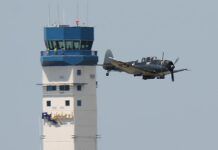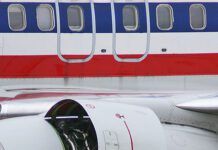Let’s begin with the conclusion: American Champion’s decision to add 30 HP to the long-serving, 180-HP Scout, to make what it calls the Denali Scout—created the stud brute of the two-place, backcountry airplane set. It keeps the honest handling and excellent ground manners of the Scout while notching up the climb rate from very good to nearly breath-taking. There are some shortcomings that we’ll outline—they are all carryovers from the original Scout and not safety of flight matters.
Adding power to an established airframe to get better performance seems like a no-brainer when it comes to improving the breed, but, power is destabilizing—the airframe and control system may need significant changes. Second, there really ain’t a free lunch—more power means more weight in the engine room, accommodating a different, probably bigger, prop and figuring out how to store and supply fuel for a hungrier engine. Oh, yeah, there is going to be a whole new vibration harmonic for the airframe to compensate for (cracked structure is no joke), and the empennage is going to have to absorb higher intensity power pulses with each passage of a prop blade.
After flying the Lycoming IO-360-A1B6-equipped Denali with the new four-into-one exhaust system, new metal cowling and new, larger horizontal tail with an airfoil, rather than flat, cross section, it seems to me American Champion engineers did a nice job of incorporating the power into the airframe.
American Champion Denali Scout Fuel System
The fuel system remains the same as the 180-HP Scout. It is a dirt-simple, off-on arrangement (accident data has long shown off/on systems to be the safest) with 35 gallons of usable fuel in two wing tanks. 35 gallons isn’t much—so there is an optional system that adds another 35 gallons of usable fuel by plumbing in a second tank just outboard of the standard tank in each wing (apparently almost all buyers order the extra tankage).
The Denali Scout inboard and outboard tanks are connected by three fuel lines—smaller ones down low, fore and aft, and a three-inch line near the middle of the tank. The four tanks are also connected at the top of each by a line that goes to a single fuel vent below the right wing. The fuel caps are not vented. From a belt and suspenders perspective, I’d like to see a secondary vent.
The fuel fillers are located in the outboard tanks of the optional system—so as the tanks are filled, the fuel flows from the outboard into the inboard tanks due to wing dihedral. Because fuel can be added faster than it can flow into the inboard tank, to completely fill the tanks, it may be necessary to wait a few minutes after a tank first appears to be full, and then add more to top it off.
70 gallons gives excellent endurance, but filling the tanks in the Denali Scout I flew meant the airplane was single-place—only 288 pounds could be carried in the cabin. The Denali Scout has what I consider to be a very good useful load—708 pounds in the one I examined. With two 200-pounders in the seats, 51 gallons of fuel could be carried, plenty for most flights.
The problem I ran into was figuring out how much fuel was in the airplane. The float-type gauging system gives a rough estimate of quantity and does clearly show when the fuel is getting low, but that’s it. I suspect owners will either create measuring dip sticks for preflight, order the optional JPI EDM-930 Engine Data Management System and track fuel flow and quantity added or simply add fuel until “it looks about right” and accept that they may be flying over gross.

American Champion will install just about any avionics package a buyer desires, from bare bones through an Aspen glass panel. The basic Denali Scout includes VFR instrumentation.
I have always thought well of American Champion’s crashworthiness design. Fuel is contained in metal tanks that are between the wing spars. The Denali I flew had a five-point restraint system and the quick release cabin door. Being able to jettison the door prior to a forced landing, in my opinion, increases the chances for the occupants to get safely out of the airplane after it comes to a stop.
American Champion Denali Scout Weight and Balance
American Champion managed to put a 48-pound heavier engine into the Denali Scout, yet only lost about 20 pounds of useful load from the original Scout. Both have the same, 2150-pound gross weight. There is no issue with running out of the front end of the c.g. range when flying solo, with no baggage. I did a number of weight and balance calculations and did not run into fore or aft limitations with any loading combination. The main baggage compartment has a 10.4 cubic foot capacity and can carry 100 pounds. The airplane I flew had the optional 3.6-cubic-foot extended aft baggage area that holds 30 pounds.
The fit and finish of the Denali Scout was very good—far better than new airplanes used to be—but not quite to the level that is expected for a current new airplane that costs well into six figures. There was some overspray on interior panels and a mismatch on some interior colors. When a new $40,000 truck has virtually perfect fit and finish, I think it’s reasonable that a quarter-million-dollar airplane be at the same level.
American Champion Denali Scout Price
Base price for the Denali Scout is $264,900, $25,000 more than the 180-HP Scout (2016 prices, Ed) and competitive for new airplanes in its peer group. The airplane I flew for this article had a number of options, including 31-inch bush wheels, wide rear seat, extended baggage, long-range tanks and a basic avionics package.
In working with American Champion to set up this review, it was recommended that I fly the Denali Scout in the backcountry where it could show what it could do. I flew it into the Idaho wilderness, including a stop at Sulfur Creek Ranch, with Kasey Lindsay, an experienced off-airport pilot and American Champion dealer.

The walk around inspection of the Denali is conventional; there are six fuel drains with the long-range tanks, and you need a screwdriver to open the cowling halves. The Scout sits high normally; due to its beefed up landing gear for better prop clearance—but the 31-inch Alaskan Bush Wheels really made this Denali stand tall. Nevertheless, boarding was easy—far easier than a Super Cub—with the step in a right place and plenty of room to maneuver into either seat. There was plenty of shoulder and head room and adequate leg room in both seats. The front seat is adjustable. At 6’4″ tall, it was more comfortable for me than either a Super Cub or Husky.
Starting is performed with the mixture at idle cutoff—it’s advanced when the fuel-injected engine fires. Lindsay and I made a number of hot starts during the day and did not have any problem doing so.
American Champion Denali Scout Performance
The Scout has excellent visibility over the nose, one of the reasons it’s a good bush airplane. However, with the 31″ wheels on this Denali, the nose was high enough that S turns were needed when taxiing. One of the major concerns in backcountry flying is being able to see obstructions on a runway. That proved not to be a problem on the Denali as the tail could be raised immediately on takeoff, giving the ability to see the runway clearly.
Published takeoff distances are a 388-foot ground roll and 708 feet to clear a 50-foot obstacle at sea level. 14 degrees of flaps are used; liftoff is at 50 MPH (American Champion uses MPH in its manuals, except for publishing a 15-knot maximum demonstrated crosswind component). Best angle of climb speed is 56 MPH. With the wide-chord, two-blade MT prop being swung by 210 HP, the Denali’s angle and rate of climb is impressive. Best rate of climb is 82 MPH—the manual shows a 1428 FPM rate of climb at sea level. The engine is flat-rated, so climbs are performed at 2700 RPM and full throttle.

The Denali I flew did not have a vertical speed indicator, but a portion of the flights Lindsay and I made were in company with a 180-HP Scout. Loaded to near gross weight, the Denali handily out climbed the standard Scout. In cruise, at similar power settings, the Denali was slightly faster.
Book cruise figures for the Denali at 9000 feet are 143 MPH at 75 percent power and a fuel burn of 12.2 GPH and 130 MPH at 65 percent power with a fuel burn of 8.2 GPH. I found it impossible to get cruise numbers in the Denali. It did not have any EGT gauging (something that makes no sense). I tried to use the American Champion book technique for leaning—lean until the engine begins to run rough and then turn the mixture knob back in three full turns. The idea is to run at 150 degrees rich of peak EGT for best power.
The problem I had was that the engine never began to run rough. It would go smoothly from rich of peak to lean of peak—there was no way to discern peak EGT. In my opinion, an engine monitor should be standard equipment on the Denali Scout.
Book cruise numbers and the experience flying level with the 180-HP Scout confirmed my initial opinion about adding power to the Scout—the extra power of the Denali would generate impressive climb performance but not much extra cruise speed.
Assuming the book is correct, going from 65 to 75 percent power gives a 13 MPH speed increase—but that comes at a cost of an extra four GPH, a nearly 50 percent increase in fuel burn.
In cruise, you can’t fly it with the window open or door. It’s a little thing, but it’s a big thing—dealers tell me that the demographic of most purchasers of new, backcountry airplanes are folks who buy them as a second or third airplane purely for fun and to look cool on the ramp—and being able to motor around with their clothes blowing in the breeze is a huge part of the mystique. In my opinion, American Champion needs to figure that out.
American Champion Denali Scout Handling
Handling is honest and predictable, with one glitch—it’s solid in pitch, light in yaw and, with aileron spades installed, requires only moderate force in roll. However, the aileron design, combined with outboard-mounted spades, generates massive adverse aileron yaw.
I especially liked the Denali Scout trim system—it works from a sliding knob below the throttle quadrant—it’s fast, positive and effective.
The airplane was rock solid in slow flight—I trimmed it for hands-off flight at 49 MPH IAS.
Stalls were consistent with the Citabria line—mild, with no roll off if the ball is centered. They proved consistent with the published speeds of 54 MPH clean and 45 MPH with full flaps.
Approaching for landing, the Denali Scout slows easily to about 85 MPH, well within the white arc for flap deflection. There is a notable pitch down with flap extension—so the nose is well down, giving excellent visibility on approach. Full flaps are only 27 degrees and didn’t seem to provide a lot of drag. Normal approach speed is 75 MPH. For backcountry work, a short field approach speed of 58 MPH is used.
The Denali also slips well, so it can plummet toward the runway and recover cleanly for touchdown. Throttle response was immediate and linear, so the approach could be modulated precisely and a go around quickly initiated.

Tail-low wheel landings are the preferred backcountry technique in the big-tire Denali Scout, as they minimize energy at touchdown while allowing the pilot to see the runway surface clearly. They proved amazingly easy to accomplish. In addition, by raising the tail slightly just after touchdown, the angle of attack was reduced so the airplane was firmly on the ground and the weight was on the mains so braking could be effective.
Conclusion
The additional 30 HP and engineering work to integrate it has, to me, allowed American Champion to improve on one of the best backcountry airplanes on the market. Is it worth $25,000 (2016 prices) more than the Scout? That’s a marketing question, and given that I was told the demographic for these airplanes is a male who has at least one other airplane and wants a hotrod to play safely in the backcountry, I think the extra power and performance may be a bargain for them.
Backcountry Airplanes, Attributes
There are a lot of airplanes that are alleged to be good for backcountry operations by pilots who want to seriously recreate. Most of them have been reviewed in this magazine.
The Denali Scout I flew for this review was made available by Northwest Backcountry Aircraft of Nampa, Idaho—and I spent an extended period speaking with the proprietors, Kasey Lindsay and Bob Hannah, experienced backcountry pilots, about what makes a good airplane for that type of flying. I’ve combined their thoughts along with reviews in this magazine of rugged, utility airplanes, to come up with a list of attributes of a good backcountry airplane.
Landing gear strength and stability. It has to absorb punishment from solid touchdowns as well as ever-present rocks, brush and holes. The brake lines should be protected as there’s a good chance a gear leg is going to strike something that could break an exposed brake line.
The gear geometry should make ground handling as easy as possible and minimize the risk of nose over in tailwheel airplanes. The most common cause of accidents in backcountry flying is loss of control on landing—gear design matters.
Good visibility over the nose during all phases of landing and takeoff. Hitting obstructions short of, on the runway and just after liftoff are common cause of backcountry accidents. An airplane that has the nose block forward visibility is at risk of hitting something. The nosewheel King Katmai is proving popular partially because of its good visibility over the nose. The design of a tailwheel airplane should allow a competent pilot to apply the brakes while the tail is off of the ground to allow good visibility over the nose and maximize deceleration.
Suitable stability in pitch to allow precise speed control on final.
Flaps should provide high drag and rapid deceleration so the airplane doesn’t float if the pilot isn’t perfect with airspeed control.
A design that allows installation of oversize tires.
Power. Lots of it. When things go wrong, the ability to climb steeply and rapidly may mean everything. As Kasey Lindsay put it, the airplane has to be able to “climb like a rocket and come out of the sky like a piano.”
No nasty behavior in a slip—and the ability slip steeply, hold the slip into the flare and straighten out at the last moment.
Good prop clearance.
High wing for brush clearance.
Good overall visibility. When maneuvering for a runway in a canyon, a skylight means you can see what you need to see in a steep turn. Having lots of window area, with few bars and posts that can get in the way is important—especially when looking down and aft, something you do surprisingly often.
Excellent control response in gusty crosswinds and the ability to pin the airplane after landing so a gust doesn’t put it back into the air.
Easy access to the flap control.
Easy to use, fast-acting trim system.
The ability to go around at the last possible moment, without a lot of trim change when going to full power in landing configuration—you don’t want to have to be stiff-arming the stick or yoke while you’re trying to get maximum performance out of the airplane.
A good mix between STOL ability and cruise speed. Sacrificing everything for STOL means a slow airplane in cruise. The ideal backcountry airplane will handle a 500-foot strip safely and get there and back home without having to time the trip with a calendar or worry about running out of fuel.
Rick Durden is the Senior Editor of Aviation Consumer, is a CFII, holds an ATP with type ratings in the Douglas DC-3 and Cessna Citation and is the author of The Thinking Pilot’s Flight Manual or, How to Survive Flying Little Airplanes and Have a Ball Doing It, Vols. 1 & 2.
This article originally appeared in the October 2014 issue of Aviation Consumer magazine.
For more great content like this, subscribe to Aviation Consumer!



































